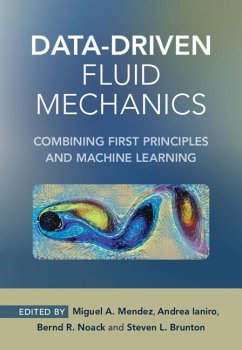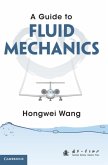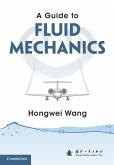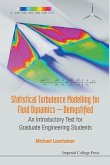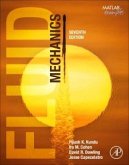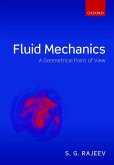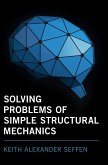Data-Driven Fluid Mechanics
Herausgeber: Mendez, Miguel A.; Noack, Bernd R.; Ianiro, Andrea
Data-Driven Fluid Mechanics
Herausgeber: Mendez, Miguel A.; Noack, Bernd R.; Ianiro, Andrea
- Gebundenes Buch
- Merkliste
- Auf die Merkliste
- Bewerten Bewerten
- Teilen
- Produkt teilen
- Produkterinnerung
- Produkterinnerung
Big data and machine learning are driving profound technological progress across nearly every industry, and are rapidly shaping fluid mechanics research. This is a self-contained and pedagogical treatment of the data-driven tools that are leading research in model-order reduction, system identification, flow control, and turbulence closures.
Andere Kunden interessierten sich auch für
![Measurement in Fluid Mechanics Measurement in Fluid Mechanics]() Stavros Tavoularis (University of Ottawa, Ottawa, Canada)Measurement in Fluid Mechanics89,99 €
Stavros Tavoularis (University of Ottawa, Ottawa, Canada)Measurement in Fluid Mechanics89,99 €![A Guide to Fluid Mechanics A Guide to Fluid Mechanics]() Hongwei Wang (Beijing Beihang University)A Guide to Fluid Mechanics114,99 €
Hongwei Wang (Beijing Beihang University)A Guide to Fluid Mechanics114,99 €![A Guide to Fluid Mechanics A Guide to Fluid Mechanics]() Hongwei Wang (Beijing Beihang University)A Guide to Fluid Mechanics61,99 €
Hongwei Wang (Beijing Beihang University)A Guide to Fluid Mechanics61,99 €![STATISTICAL TURBULENCE MODELLING FOR FLUID DYNAMICS .. STATISTICAL TURBULENCE MODELLING FOR FLUID DYNAMICS ..]() Michael Leschziner (Uk Imperial College London)STATISTICAL TURBULENCE MODELLING FOR FLUID DYNAMICS ..81,99 €
Michael Leschziner (Uk Imperial College London)STATISTICAL TURBULENCE MODELLING FOR FLUID DYNAMICS ..81,99 €![Fluid Mechanics Fluid Mechanics]() Pijush K. Kundu (U.S.A. Nova University (deceased) )Fluid Mechanics88,99 €
Pijush K. Kundu (U.S.A. Nova University (deceased) )Fluid Mechanics88,99 €![Fluid Mechanics Fluid Mechanics]() S. G. Rajeev (Professor of Physics and Professor of Ph MathematicsFluid Mechanics96,99 €
S. G. Rajeev (Professor of Physics and Professor of Ph MathematicsFluid Mechanics96,99 €![Solving Problems of Simple Structural Mechanics Solving Problems of Simple Structural Mechanics]() Keith Alexander Seffen (University of Cambridge)Solving Problems of Simple Structural Mechanics63,99 €
Keith Alexander Seffen (University of Cambridge)Solving Problems of Simple Structural Mechanics63,99 €-
-
-
Big data and machine learning are driving profound technological progress across nearly every industry, and are rapidly shaping fluid mechanics research. This is a self-contained and pedagogical treatment of the data-driven tools that are leading research in model-order reduction, system identification, flow control, and turbulence closures.
Produktdetails
- Produktdetails
- Verlag: Cambridge University Press
- Seitenzahl: 470
- Erscheinungstermin: 21. Oktober 2024
- Englisch
- Abmessung: 250mm x 175mm x 30mm
- Gewicht: 1024g
- ISBN-13: 9781108842143
- ISBN-10: 1108842143
- Artikelnr.: 64222230
- Herstellerkennzeichnung
- Libri GmbH
- Europaallee 1
- 36244 Bad Hersfeld
- gpsr@libri.de
- Verlag: Cambridge University Press
- Seitenzahl: 470
- Erscheinungstermin: 21. Oktober 2024
- Englisch
- Abmessung: 250mm x 175mm x 30mm
- Gewicht: 1024g
- ISBN-13: 9781108842143
- ISBN-10: 1108842143
- Artikelnr.: 64222230
- Herstellerkennzeichnung
- Libri GmbH
- Europaallee 1
- 36244 Bad Hersfeld
- gpsr@libri.de
Part I. Motivation: 1. Analysis, modeling and control of the cylinder wake
B. R. Noack, A. Ehlert, C. N. Nayeri and M. Morzynski; 2. Coherent
structures in turbulence: a data science perspective J. Jiménez; 3. Machine
learning in fluids: pairing methods with problems S. Brunton; Part II.
Methods from Signal Processing: 4. Continuous and discrete LTI systems M.
A. Mendez; 5. Time-frequency analysis and wavelets S. Discetti; Part III.
Data-Driven Decompositions: 6. The proper orthogonal decomposition S.
Dawson; 7. The dynamic mode decomposition: from Koopman theory to
applications P. J. Schmid; 8. Generalized and multiscale modal analysis M.
A. Mendez; 9. Good practice and applications of data-driven modal analysis
A. Ianiro; Part IV. Dynamical Systems: 10. Linear dynamical systems and
control S. Dawson; 11. Nonlinear dynamical systems S. Brunton; 12. Methods
for system identification S. Brunton; 13. Modern tools for the stability
analysis of fluid flows P. J. Schmid; Part V. Applications: 14. Machine
learning for reduced-order modeling B. R. Noack, D. Fernex and R. Semaan;
15. Advancing reacting flow simulations with data-driven models K. Zdybal,
G. D'Alessio, G. Aversano, M. R. Malik, A. Coussement, J. C. Sutherland and
A. Parente; 16. Reduced-order modeling for aerodynamic applications and
multidisciplinary design optimization S. Görtz, P. Bekemeyer, M.
Abu-Zurayk, T. Franz and M. Ripepi; 17. Machine learning for turbulence
control B. R. Noack, G. Y. Cornejo Maceda, F. Lusseyran; 18. Deep
reinforcement learning applied to active flow control J. Rabault and A.
Kuhnle; Part VI. Perspectives: 19. The Computer as scientist J. Jiménez;
References.
B. R. Noack, A. Ehlert, C. N. Nayeri and M. Morzynski; 2. Coherent
structures in turbulence: a data science perspective J. Jiménez; 3. Machine
learning in fluids: pairing methods with problems S. Brunton; Part II.
Methods from Signal Processing: 4. Continuous and discrete LTI systems M.
A. Mendez; 5. Time-frequency analysis and wavelets S. Discetti; Part III.
Data-Driven Decompositions: 6. The proper orthogonal decomposition S.
Dawson; 7. The dynamic mode decomposition: from Koopman theory to
applications P. J. Schmid; 8. Generalized and multiscale modal analysis M.
A. Mendez; 9. Good practice and applications of data-driven modal analysis
A. Ianiro; Part IV. Dynamical Systems: 10. Linear dynamical systems and
control S. Dawson; 11. Nonlinear dynamical systems S. Brunton; 12. Methods
for system identification S. Brunton; 13. Modern tools for the stability
analysis of fluid flows P. J. Schmid; Part V. Applications: 14. Machine
learning for reduced-order modeling B. R. Noack, D. Fernex and R. Semaan;
15. Advancing reacting flow simulations with data-driven models K. Zdybal,
G. D'Alessio, G. Aversano, M. R. Malik, A. Coussement, J. C. Sutherland and
A. Parente; 16. Reduced-order modeling for aerodynamic applications and
multidisciplinary design optimization S. Görtz, P. Bekemeyer, M.
Abu-Zurayk, T. Franz and M. Ripepi; 17. Machine learning for turbulence
control B. R. Noack, G. Y. Cornejo Maceda, F. Lusseyran; 18. Deep
reinforcement learning applied to active flow control J. Rabault and A.
Kuhnle; Part VI. Perspectives: 19. The Computer as scientist J. Jiménez;
References.
Part I. Motivation: 1. Analysis, modeling and control of the cylinder wake
B. R. Noack, A. Ehlert, C. N. Nayeri and M. Morzynski; 2. Coherent
structures in turbulence: a data science perspective J. Jiménez; 3. Machine
learning in fluids: pairing methods with problems S. Brunton; Part II.
Methods from Signal Processing: 4. Continuous and discrete LTI systems M.
A. Mendez; 5. Time-frequency analysis and wavelets S. Discetti; Part III.
Data-Driven Decompositions: 6. The proper orthogonal decomposition S.
Dawson; 7. The dynamic mode decomposition: from Koopman theory to
applications P. J. Schmid; 8. Generalized and multiscale modal analysis M.
A. Mendez; 9. Good practice and applications of data-driven modal analysis
A. Ianiro; Part IV. Dynamical Systems: 10. Linear dynamical systems and
control S. Dawson; 11. Nonlinear dynamical systems S. Brunton; 12. Methods
for system identification S. Brunton; 13. Modern tools for the stability
analysis of fluid flows P. J. Schmid; Part V. Applications: 14. Machine
learning for reduced-order modeling B. R. Noack, D. Fernex and R. Semaan;
15. Advancing reacting flow simulations with data-driven models K. Zdybal,
G. D'Alessio, G. Aversano, M. R. Malik, A. Coussement, J. C. Sutherland and
A. Parente; 16. Reduced-order modeling for aerodynamic applications and
multidisciplinary design optimization S. Görtz, P. Bekemeyer, M.
Abu-Zurayk, T. Franz and M. Ripepi; 17. Machine learning for turbulence
control B. R. Noack, G. Y. Cornejo Maceda, F. Lusseyran; 18. Deep
reinforcement learning applied to active flow control J. Rabault and A.
Kuhnle; Part VI. Perspectives: 19. The Computer as scientist J. Jiménez;
References.
B. R. Noack, A. Ehlert, C. N. Nayeri and M. Morzynski; 2. Coherent
structures in turbulence: a data science perspective J. Jiménez; 3. Machine
learning in fluids: pairing methods with problems S. Brunton; Part II.
Methods from Signal Processing: 4. Continuous and discrete LTI systems M.
A. Mendez; 5. Time-frequency analysis and wavelets S. Discetti; Part III.
Data-Driven Decompositions: 6. The proper orthogonal decomposition S.
Dawson; 7. The dynamic mode decomposition: from Koopman theory to
applications P. J. Schmid; 8. Generalized and multiscale modal analysis M.
A. Mendez; 9. Good practice and applications of data-driven modal analysis
A. Ianiro; Part IV. Dynamical Systems: 10. Linear dynamical systems and
control S. Dawson; 11. Nonlinear dynamical systems S. Brunton; 12. Methods
for system identification S. Brunton; 13. Modern tools for the stability
analysis of fluid flows P. J. Schmid; Part V. Applications: 14. Machine
learning for reduced-order modeling B. R. Noack, D. Fernex and R. Semaan;
15. Advancing reacting flow simulations with data-driven models K. Zdybal,
G. D'Alessio, G. Aversano, M. R. Malik, A. Coussement, J. C. Sutherland and
A. Parente; 16. Reduced-order modeling for aerodynamic applications and
multidisciplinary design optimization S. Görtz, P. Bekemeyer, M.
Abu-Zurayk, T. Franz and M. Ripepi; 17. Machine learning for turbulence
control B. R. Noack, G. Y. Cornejo Maceda, F. Lusseyran; 18. Deep
reinforcement learning applied to active flow control J. Rabault and A.
Kuhnle; Part VI. Perspectives: 19. The Computer as scientist J. Jiménez;
References.

